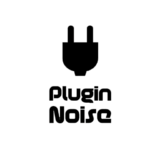Bass amp plugins have revolutionized the way I approach music production. Instead of relying on physical amps, which can be costly and require precise mic setups, I’ve found that plugins provide a level of convenience and versatility that’s hard to match. These tools allow me to craft tones ranging from the punchy, modern grit of metal to the deep, warm grooves of vintage funk, all without leaving my DAW.
For someone who loves experimenting with bass tones, they’re nothing short of a creative playground. One of the most exciting aspects of bass amp VST plugins is their ability to replicate the character and nuances of legendary hardware amps and cabinets. Some of these bass amp sims let me virtually plug into an iconic rig, while others offer innovative features that expand what I can do with my bass tracks.
I can seamlessly sculpt frequencies with precision, layer drive, clean signals, and even load custom impulse responses for a highly personalized sound. The level of control they provide is something I could only dream of a few years ago. For me, these plugins aren’t just about nailing a tone but also about workflow. Being able to audition different sounds, tweak EQs, and add effects in real-time has streamlined my production process immensely.
Whether recording a punk-inspired track or laying down a melodic bassline for a ballad, I can dial in the perfect tone in seconds. The presets some of these plugins offer are incredible starting points, especially when I’m looking for inspiration or need to quickly match a mix.
I also love how inclusive these plugins are, catering to beginners and seasoned producers. If you’re just starting, there are intuitive options that help you get great sounds without diving too deep into technical details. Conversely, advanced features like multi-band processing and parametric EQs let pros like me dig into the finer details.
We’ve compiled an exciting list of bass amp plugins to explore today. Each tool brings something unique to the table, whether it’s unmatched realism, cutting-edge features, or sheer sonic versatility. Let’s dive in and discover the best bass amp VST plugins for modern and vintage bassists alike! Before I dive in, consider checking my top 9 roundup on the best guitar amp sims.
1. Neural DSP Parallax X
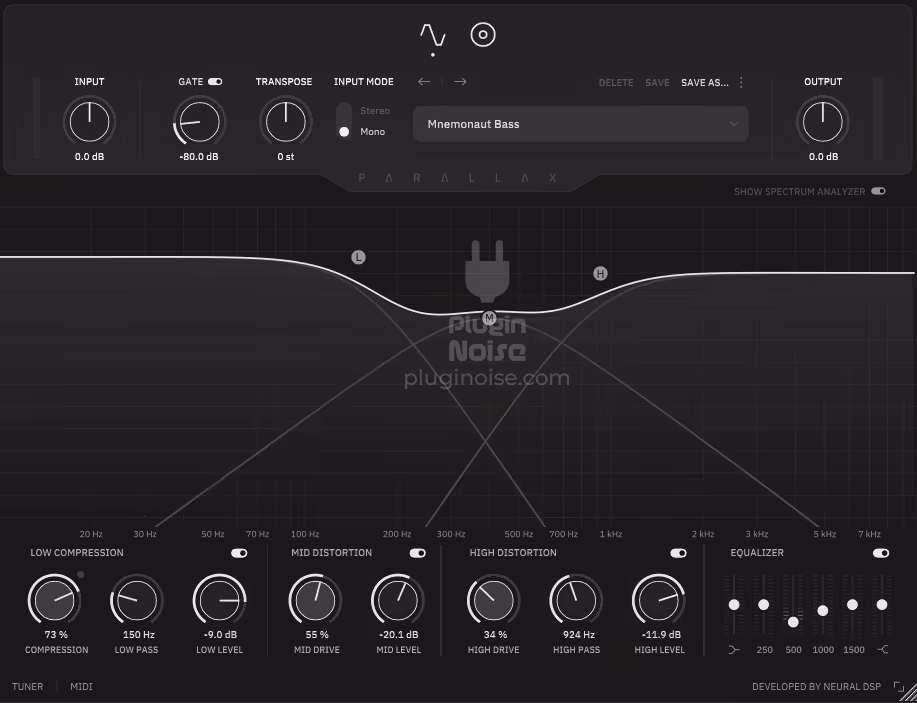
The Neural DSP Parallax X is my ultimate go-to for modern, hard-hitting bass tones. What I love most is how it lets me shape my sound precisely, dividing the bass signal into three frequency bands – lows, mids, and highs. Each band gets its dedicated processing, so I can compress the lows for punch, distort the mids for grit, and sculpt the highs for clarity. This “divide and conquer” approach is a game-changer, especially for metal and hard rock tones.
The plugin feels like a souped-up version of the classic Darkglass X7 pedal but with more freedom to tweak every parameter. I’m a huge fan of the EQ, which helps me fine-tune the tone for any mix, and the built-in cab simulation, which adds depth and realism to my sound. The cab section is fully customizable, letting me mix and match microphones, adjust mic positions, and even load my own impulse responses.
One of the coolest features for me is the transpose option, which lets me shift the pitch up or down by an octave that is perfect for experimenting with extended-range tones or drop tunings. The plugin also includes over 100 presets and 50 IRs, giving me endless tonal options right out of the box. Parallax X delivers incredible versatility, whether I need bone-crushing distortion or a fat, clean bass tone.
I also love how easy it is to dial in a sound. The interface is clean and intuitive, with features like an input gate to tame unwanted noise and the ability to disable individual bands for creative experimentation. Even when I’m not using distortion, the compression and cab simulation alone make this bass amp sim a powerful tool for all bass styles.
I think Parallax X is one of the most fascinating bass amp plugins out there. It’s perfect for modern metal tones but equally capable of delivering subtle, clean sounds. Whether I’m crafting intricate basslines or just jamming, this plugin always inspires creativity.
The Neural DSP Parallax X is compatible with macOS and Windows and supports VST, AU, and AAX formats. It also works as a standalone plugin with a built-in tuner and metronome.
2. Native Instruments Guitar Rig 7 Pro
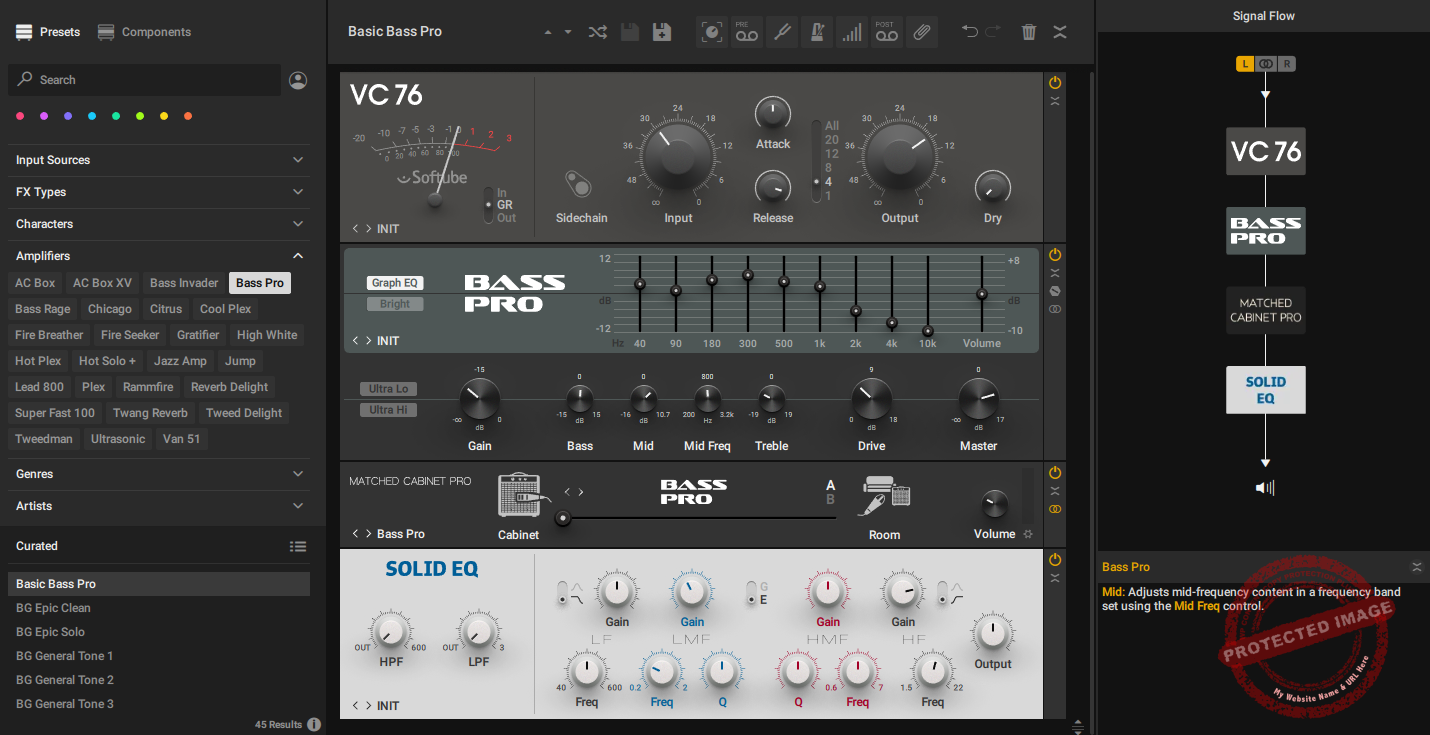
Guitar Rig 7 Pro is an all-in-one solution for creating bass tones that are rich and inspiring. While its name might suggest it’s solely for guitars, I’ve found it equally exceptional for bass applications. What I love most is the modular setup where I can mix and match amps, effects, and cabs to craft tones for everything from warm vintage grooves to crushing modern basslines.
One standout feature for me is the cabinet IR loader, which lets me integrate custom impulse responses, adding an authentic, room-like feel to my bass tracks. Paired with the super-fast 100 amp, the plugin delivers clean, tight, low-end, and overdriven warmth without losing definition. The user-friendly interface makes it simple to experiment with the signal flow, rearranging components, and trying new chains with just a few clicks.
I’ve had a blast with the new lo-fi effects. For bass, modules like Tape Wobble and Color add unique textures, ranging from gritty, saturated tones to warm, vintage-style character. The vintage vibrato is perfect for adding subtle motion to basslines, and the Ozone maximizer ensures the final output hits hard without distortion. Combined with its massive preset library, Guitar Rig 7 Pro offers endless possibilities to shape your tone.
Whether I’m jamming live, recording in a DAW, or just exploring ideas, Guitar Rig, 7 Pro feels like a creative playground. It’s not just about achieving realistic amp tones; it’s about pushing boundaries and crafting unique soundscapes. I think this plugin is an absolute must-have for any bassist looking to expand their tonal palette while maintaining a high level of control and creativity.
Guitar Rig 7 Pro is compatible with macOS and Windows, supporting VST, AU, and AAX formats. It also functions as a standalone application, making it ideal for studio and standalone jamming.
3. MMS Seismic | Bass Suite
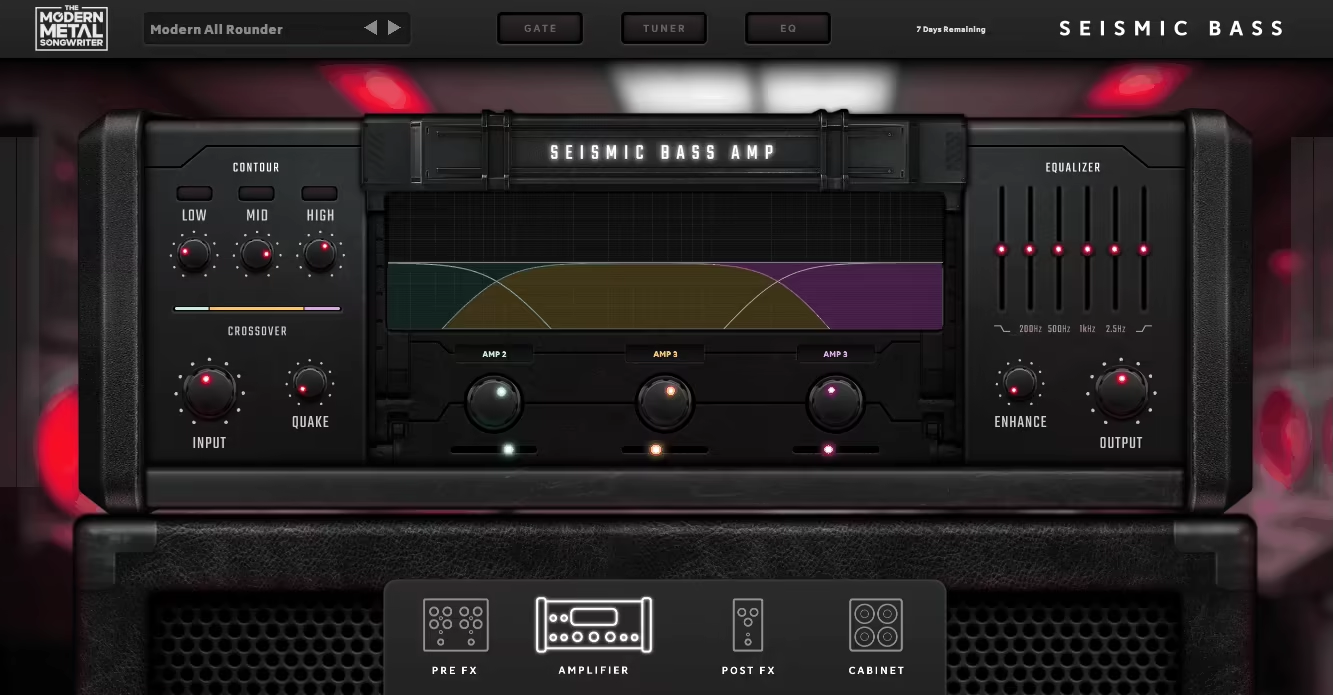
The MMS Seismic Bass Suite is hands down one of the most comprehensive bass amp VST plugins I’ve ever used. What sets it apart for me is its modular design, which allows me to control every aspect of my tone with precision. Starting with the three amp models, I can switch between clean, all-rounder, and aggressive modern tones, which cover everything from smooth jazz to crushing metal. I especially love the Quake knob, which adds subharmonics for a massive low-end presence great for tracks where I want the bass to feel huge.
The pre-effects section is a dream for tone shaping. With a fuzz pedal, overdrive, compressor, and a modern distortion unit, I have all the tools I need to create everything from subtle warmth to gritty chaos. The fact that I can rearrange the signal chain gives me even more control, letting me experiment with how the effects interact. The built-in tuner and noise gate also make setup a breeze, especially when working with high-gain tones.
The cabinet simulation is another highlight. With two cabs (4×10 and 1×15) and five microphone options, I can mix and match mic positions and levels to craft the perfect sound. I often use the blend slider to emphasize different frequencies or create unique stereo effects. If I want to use third-party cab plugins, I can bypass the built-in cab section with a single click, which is super convenient.
The post-effects and EQ options are equally impressive. The plugin provides all the tools I need to polish my tone, whether adding reverb, delay, or fine-tuning specific frequencies. The enhance knob, which applies an EQ curve inspired by classic bass preamps, is one of my favorite features for quickly dialing in a rich and professional sound.
In my experience, the Seismic Bass Suite is more than just an amp sim because it’s a complete bass production toolkit. Whether I’m working on tight, clean tones or aggressive, driven basslines, this bass amp simulator/plugin delivers on every front.
The MMS Seismic Bass Suite is compatible with macOS and Windows, supporting VST, AU, and AAX formats for use in all major DAWs.
4. IK Multimedia AmpliTube 5
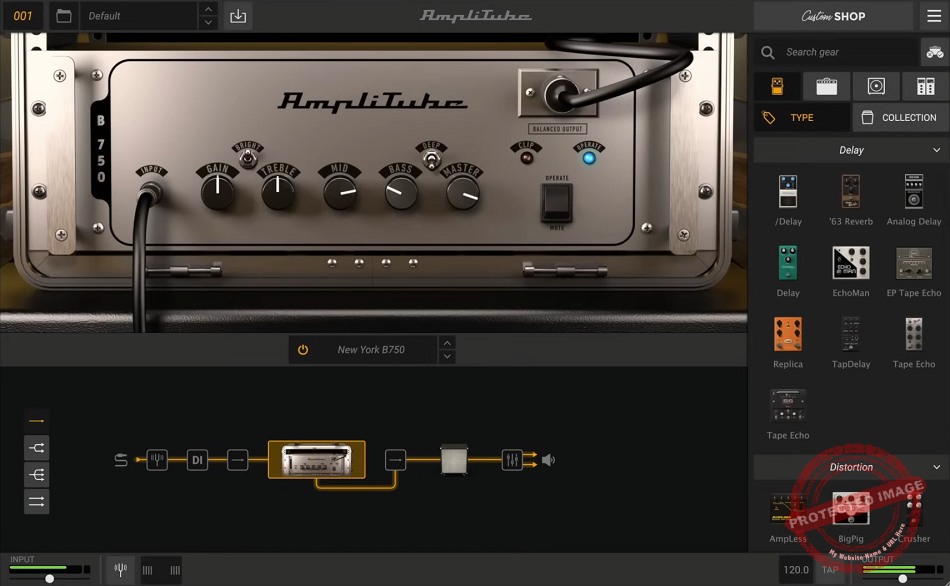
AmpliTube 5 from IK Multimedia is one of the best bass amp plugin simulators and effect suites that delivers unmatched realism and flexibility. One of my favorite things about it is its intuitive interface, which offers plenty of room for experimentation. Whether I want to replicate classic tones or sculpt modern, experimental sounds, AmpliTube 5 provides everything I need within a single platform.
I especially love how the ToneX integration works seamlessly within AmpliTube 5. After capturing my favorite amp settings in ToneX, I can import them into AmpliTube and mix them with post-effects like reverb and delay to craft professional-grade tones. This integration creates a fluid workflow that saves me from juggling multiple tools.
The variety of pedals and amps available is staggering. For bass, the multi-effects chain is a game-changer. I can add compression, EQ, and overdrive to craft everything from vintage warmth to high-gain grit. The cabinet simulation options let me use built-in IRs or load custom ones to shape my sound further. Tweaking microphone placements and blending mic tones has been invaluable for achieving depth and realism in my mixes.
Another highlight is the flexibility of signal routing. I can place effects pre- or post-amp and even set up split signal paths for intricate tonal layering. The built-in tuner and modulation effects like tremolo make this a versatile all-in-one solution for live playing and recording alike.
From classic tones to cutting-edge creativity, AmpliTube 5 has become one of my go-to tools for bass production. Whether you’re a beginner or a seasoned pro, there’s something here for everyone.
AmpliTube 5 is compatible with macOS and Windows, supporting VST, AU, and AAX formats. It also functions as a standalone application, perfect for jamming or sketching ideas without needing a DAW.
You can check our detailed AmpliTube 5 review here.
5. BIAS Amp 2 Pro
BIAS Amp 2 Pro by Positive Grid is a powerful amp modeling plugin that puts a fully customizable tube amp in your hands, just virtually. From tweaking preamps and power amps to swapping out tubes and transformers, this plugin offers unparalleled control over every aspect of your tone. As someone who enjoys dialing in unique sounds, I found the detailed amp-building interface intuitive and fun. The ability to modify even the tolex and front plate adds a touch of personality to your creations.
The standout feature for me is Amp Match, which lets you capture the tone of your physical amp and replicate it in the software. Combined with the Tone Cloud, an online repository of official and user-created amp matches, you can explore a universe of tones. While some presets are better than others, the rating system helps you sift through to find the gems. The stock presets are surprisingly versatile for lazy days, spanning clean, crunchy, and high-gain styles.
Another highlight is the clean and visually engaging interface, which makes complex adjustments feel approachable. Whether I’m swapping out tubes or tweaking EQ, I appreciate how seamlessly it all comes together. The level of realism in the tone, especially for bass amps, is remarkable. With its IR loader, you can integrate your custom cabinet setups for further sonic precision.
If you’re looking for a mobile solution, BIAS Amp 2 Pro also works on iPads and iPhones, letting you carry your tone anywhere with the right adapter. This mix of versatility, tone quality, and creative potential has made it an essential tool in my workflow.
BIAS Amp 2 Pro is available for macOS and Windows in VST, AU, and AAX formats. It’s compatible with major DAWs and offers a standalone version for practice and quick recording sessions.
6. Nembrini Audio Bass Hammer

The Nembrini Audio Bass Hammer plugin is a must-have for bassists who want the perfect mix of analog warmth and digital precision. Inspired by the legendary Tone Hammer preamp/D.I. pedal, this bass amp sim/plugin immediately feels familiar while offering a host of modern enhancements. When I first tried it, I was amazed by how naturally it handled my bass dynamics, delivering a tone that felt responsive and alive.
The first thing that stood out to me was the Drive section. The gain and blend controls allowed me to flexibly shape my sound. Whether I wanted a subtle edge to my clean tone or a gritty overdrive for rock tracks, the Bass Hammer delivered easily. I especially loved the Adaptive Gain Sculpting (AGS) feature, which reacts dynamically to how I play, creating a tone that feels like it’s breathing with my performance. This level of interaction made it an immediate standout among the bass plugins I’ve used.
The three-band EQ section is another highlight. With the ability to fine-tune mid frequencies, I could carve out space in the mix or add presence to my basslines effortlessly. The graphical interface made it intuitive to see exactly what I was doing, which saved me a lot of time tweaking and experimenting. I found myself dialing in tones quickly, whether it was a warm vintage vibe for slower songs or a sharp, cutting edge for faster, aggressive pieces.
The Cabinet Section added another layer of tonal richness. With four cab models to choose from, each with multiple mic options, I could create a wide range of sounds. Adjusting the mic positions and mixing ambient room tones was easy, and I even experimented with the Impulse Loader to blend in third-party IRs. The level of detail available here makes it ideal for studio recording and live setups. I achieved a full, round bass tone that sat perfectly in my mixes.
I also appreciated the practical features like the built-in Noise Gate and Compressor, which helped clean up my signal and control dynamics without losing warmth or punch. The D.I. Parallel Output added flexibility by letting me shape a polished tone for direct recording, complete with console-style compression. Every aspect of this plugin felt like it was designed with real-world bass recording and performance in mind.
The Nembrini Audio Bass Hammer is available for macOS and Windows and supports all major formats, including VST2, VST3, AAX, and AU, ensuring compatibility with virtually every DAW.
7. Ampeg SVT-3 PRO

The Ampeg SVT-3 PRO plugin bass amp VST plugin is an exceptional tool to harness the warmth and punch of a classic tube-driven amp in a modern, portable format. Based on the iconic SVT-3 PRO head, this plugin captures the essence of the hardware with stunning accuracy. For me, the standout feature is the dynamic preamp section, which houses five tubes. This setup ensures that every note resonates with that signature Ampeg richness, making it ideal for players who value clarity and depth in their tone.
What sets this amp apart is its unparalleled EQ versatility. The three-band EQ with selectable midrange frequencies allows for precise tonal shaping. I found it incredibly responsive as I switched between the five frequency presets, ranging from bass-heavy thumps to punchy, articulate mids. Dialing in the perfect tone became a straightforward process, and exploring how each setting influenced my sound was exciting. Whether I was looking for a deep growl or a smooth, balanced tone, the EQ delivered every time.
Another highlight is the Tube Gain control. This knob adjusts the voltage sent to the tubes, effectively letting me shape the amp’s responsiveness. Turning it up provided a more solid-state-like attack, while dialing it back brought out a traditional tube amp’s warm, slow-response characteristics. I preferred a middle-ground setting that balanced clarity with a hint of vintage tube sag.
The plugin’s Graphic EQ is a game-changer for me. As a pick player who thrives on midrange-heavy tones, it allowed me to sculpt my sound with surgical precision. Boosting certain frequencies while cutting others gave my basslines a focused presence in the mix without muddying the low end. The included compressor also came in handy for taming peaks and enhancing sustain, ensuring that every note carried the same weight and impact.
I also loved the Limiter feature. While the hardware SVT-3 PRO’s peak light can be intimidating for beginners, this bass amp simulator simplifies things by letting you push the gain hard without sacrificing tone or clarity. I could achieve that sought-after tube-driven warmth without worrying about overloading the signal. The D.I. output adds further flexibility, making capturing clean tones easy or pairing the plugin with other effects for creative sound design.
The Ampeg SVT-3 PRO plugin is compatible with Windows and macOS and supports major formats like VST, AAX, and AU. It’s an excellent addition for bassists seeking the iconic Ampeg tone in a digital format that fits seamlessly into any DAW.
8. Softube Amp Room Bass Suite
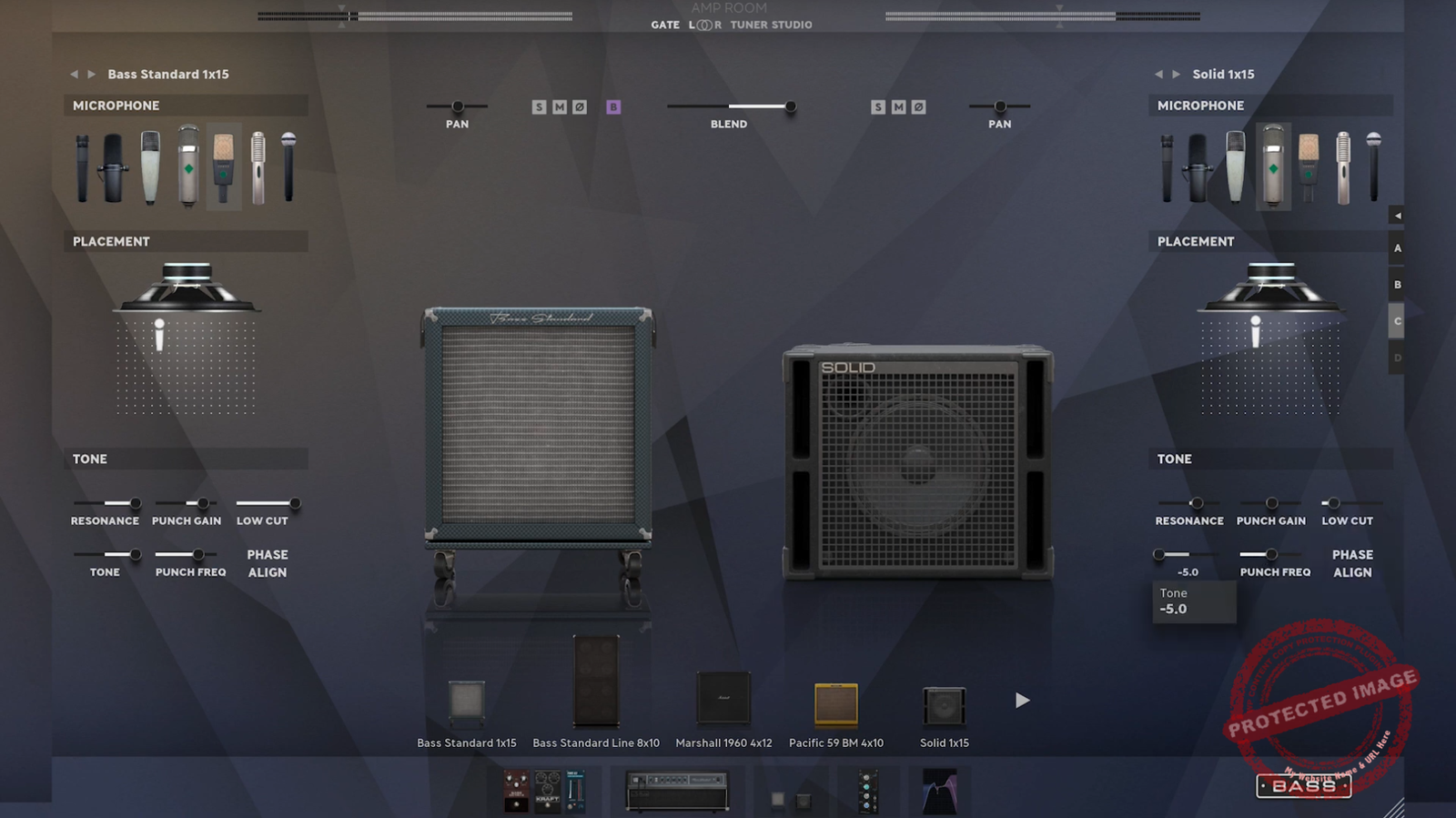
The Softube Amp Room Bass Suite plugin offers a powerful and flexible platform for bassists looking to get the most out of their virtual rig. For me, one of the biggest advantages of this plugin is that it is user-friendly while still offering a depth of customization that allows me to craft unique tones easily. It starts with the basics: I can adjust the normal and master volume, as well as control the bass, mids, and treble.
The EQ section is intuitive and allows me to shape my sound quickly, whether for something tight and punchy or smooth and round. The ability to switch between different cabinets, such as the 8×10, 4×12, and a vintage 1×12, really sets this plugin apart. I can fine-tune my sound by moving the mic position in and out of the cabinet and adjusting its angle to achieve off-axis sounds. For me, this interaction between the mic and cabinet adds a layer of depth and presence that’s crucial for capturing that “live” feel.
There’s also a DI section that I find invaluable. I can blend the DI signal with the amp cab section for more tonal control or choose to bypass one or the other, depending on the sound I’m going for. This level of versatility makes it ideal for both traditional bass tones and more experimental applications.
Another feature that I really enjoy is the ability to fine-tune the controls with a finer resolution by holding the command key. This gives me precise control over things like the low-cut and high-cut filters, which I often tweak to find the perfect balance in my mix. The plugin also lets me bypass the amp or cabinet entirely, which is great for creative experimentation. For instance, I can use just the cabinet section to add a unique character to vocals, drum loops, or synths.
I’ve found that the plugin really shines when blending different cabinet and DI tones. I can scoop the mids or enhance them for a more aggressive sound, depending on the vibe I’m after.
The subtlety of how the amp and cab combinations interact with the EQ and DI blending allows me to create everything from deep, dubby bass lines to more modern, cutting-edge tones. The ability to adjust mic distance and position adds an organic feel, giving the plugin a certain realism that sets it apart from other amp sims.
The Softube Amp Room Bass Suite is compatible with macOS and Windows and supports VST, AU, and AAX formats. It integrates seamlessly with DAWs like Ableton Live, Logic Pro, and Pro Tools, making it a versatile addition to any setup.
9. Brainworx bx_bassdude
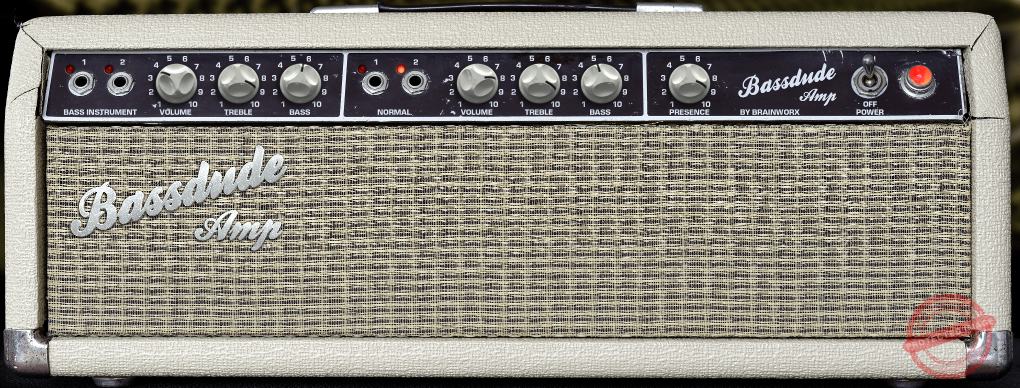
The Brainworx bx_bassdude bass amp VST immediately grabbed my attention as soon as I tried it. For anyone looking to add that vintage Fender amp sound to their bass tracks, this is a great option. It uses component-level modeling to authentically recreate the warmth and body of a classic Fender bass amp, which is something I really appreciate in a plugin.
I had a blast cranking the controls on this one, especially for both rhythm and lead tracks. The amp offers a range of tonal possibilities, and I could easily dial in that gritty, saturated sound that’s typical of those vintage Fender amps. One feature I really enjoyed was the VIN delay found in the effects rack, which added a nice touch of ambiance, making the bass tracks more dynamic and engaging in the mix.
The ease of use really stood out to me. I dove into the presets right away, and they fit into my mix almost immediately. This bass amp sim offers great starting points for anyone who doesn’t want to spend too much time tweaking. But what I loved most was how it responded when I dialed in my own settings. Whether I’m going for something aggressive or cleaner, the bx_bassdude adapts, and I can get exactly the kind of tone I’m after. Plus, with the effects rack, I had even more options for shaping my sound, and I quickly found myself playing around with different combinations of amp and effects.
The bx_bassdude gives you that classic vintage tone you crave while offering the versatility to explore and customize. It’s a great choice if you want to bring some warmth and grit to your bass tracks without needing the physical space or weight of a real amp. It can indeed be considered as one of the best bass amp plugins out there.
The bx_bassdude is compatible with both macOS and Windows and supports VST, AU, and AAX formats, so it’s perfect for most DAWs, including Pro Tools, Ableton Live, and Logic Pro.
10. Nembrini Audio Bass Driver Multiband Overdrive

The Nembrini Audio Bass Driver Multiband Overdrive is a fantastic tool for anyone looking to bring a classic Fender amp sound into their digital setup. This plugin is essentially a three-band distortion amp simulator based on the popular Tech21 Bass Driver DI pedal but expanded into the digital realm for ultimate flexibility. Right off the bat, I found the interface intuitive and very responsive, with clear visual controls that make dialing in my tones straightforward and fast.
One of the things that really stood out to me about this bass amp simulator is the level of control it offers. I can adjust the crossover points for each band to fine-tune my sound, choosing between different frequencies to suit my style. There are also sliders for blend, compression, and level for each band, allowing for complete customization of the tone.
Plus, the integrated IR loader and cabinet options let you experiment with different mic positions and cabinets to get the perfect tone without having to mic up a real cab, which is great for quick recording sessions or live performances.
The Nembrini Audio Bass Driver Multiband Overdrive is compatible with macOS and Windows platforms and supports VST, AU, and AAX formats, so it should fit right into most DAWs without a hitch.

